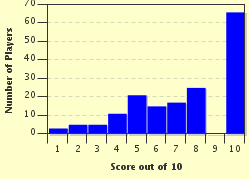Quiz Answer Key and Fun Facts
1. The only integer which is neither positive nor negative.
2. The smallest perfect number.
3. Number of dimensions of a plane (mathematical, not aeronautical).
4. Number of faces on an icosahedron.
5. The fifth triangular number.
6. Number of faces on a cube.
7. Number of equal sides in an isosceles triangle.
8. Number of vertices on a cube.
9. The only positive integer which is neither prime nor composite.
10. Number of dimensions of a tesseract.
Source: Author
looney_tunes
This quiz was reviewed by FunTrivia editor
rossian before going online.
Any errors found in FunTrivia content are routinely corrected through our feedback system.


